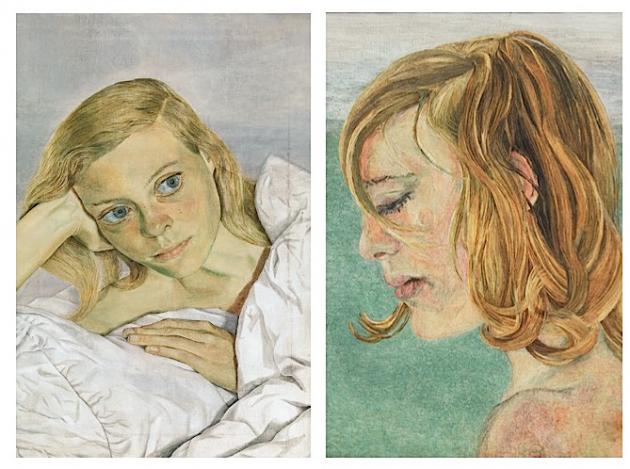An exhibition dedicated to Lucian Freud’s portraits of his first wife Caroline Blackwood, the eldest child of the 4th Marquess of Dufferin and Ava and the brewery heiress Maureen Guinness has been announced by the Ordovas gallery, in Savile Row.
When Caroline was just 21, she eloped with Freud to Paris, before marrying him a year later in 1953. On public display from 5 June to 1 August, the exhibition chronicles Caroline’s relationship with Freud through a series of portraits painted between 1950 and 1956, and includes Girl in Bed and Girl Reading, both painted in 1952, and Girl by the Sea, 1956, Freud’s last portrait of Caroline, now revealed as having been painted in Pedregalejo near Malaga, Spain. The Sisters, a delicate canvas depicting the eye of Caroline, will also be shown for the first time in the UK. Photographic and archival material includes the first public exhibition of the leather-bound notebook Caroline took to her initial sitting for Freud at Delamere Terrace. Freud’s portraits of Caroline Blackwood were thought aggressive at the time, almost brutal in the way that they made a young girl seem old but since then have come to be seen as among the artist’s most tender and beautiful works.
In 1949 Caroline, then eighteen years old, was introduced to Freud at a formal ball; he was sepa- rated from but still married to Kitty, the daughter of Kathleen Garman and Jacob Epstein. Caroline, strikingly beautiful with her big blue-green eyes, a woman of extraordinary spirit and intelligence, soon became the new face of his paintings. Caroline moved into Freud’s studio in Paddington and in 1952 they eloped to Paris, living for a year at the Hôtel la Louisiane above the Buci market. During this time, Freud painted Girl in Bed and Girl Reading among other works, highlighting Caroline’s golden skin tones, freckles, a reddish nose and suggestions of veins under the skin.
On 9 December 1953 Freud and Caroline Blackwood were married in a civil ceremony at the Chelsea Register Office in London. During their three-year marriage they lived in Dean Street W1. ‘I had dinner with [Francis Bacon] nearly every night for more or less the whole of my marriage to Lucian,’ Caroline later recalled, describing her marriage to Lucian as ‘a whole kind of Soho life. Going out to Wheeler’s, and then the Colony and the Gargoyle, was the thing with that crowd – Francis Bacon, James Pope-Hennessey, John Minton, Cyril Connolly.’ Freud’s gambling and gen- eral recklessness led to the break-up of their marriage in 1956, with his last painting of Caroline, Girl by the Sea, 1956, being completed shortly before she left him; research undertaken for the exhibition catalougue has revealed that this work was painted in Pedregalejo near Malaga, Spain.
In Caroline, Freud had found his social and intellectual match and he was said to be so devastated after she moved to New York, that his friends, including Francis Bacon, feared for a time that he would take his own life. Their divorce was filed in 1957 and granted in 1959.
Caroline Blackwood became a celebrated author and well-known figure in the literary world through her journalism and her novels, which include The Stepdaughter, 1976, awarded the David Higham Prize, and Great Granny Webster, 1977, shortlisted for the Booker Prize. She also wrote the acclaimed non-fiction book The Last of the Duchess, which described her experience of writing about Wallis Simpson, Duchess of Windsor.
After Caroline and Lucian divorced, Caroline married the composer, Israel Citkowitz, and later the poet Robert Lowell; their relationship is documented in his Pulitzer Prize-winning collection,
The Dolphin, and in his last work, Day by Day. Caroline’s bond with Lucian Freud lasted all her life. In her final illness in 1996, a living wake was arranged in her hotel room in New York, described by one of her friends, Lord Gowrie, as a ‘floating party’. The visitors were interrupted by a transatlan- tic phone call coming through. It was Lucian Freud; the two of them talked for nearly half an hour, a private last goodbye.

